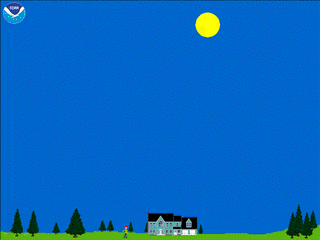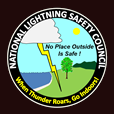
National Lightning Safety Council
- Lightning Safety
Council Home - Lightning
Science - Personal
Safety - Sports and
Recreational Activities - Medical
Information - Lightning
Protection - U.S. Lightning
Fatalities - Lightning Safety
Awareness Week - Resources
Recursos - FAQs
- About/Meet the
Lightning Safety Council - Our
Partners
The Science of Thunderstorms and Lightning
- Dr. Vladimir Rakov, University of Florida
- Dr. E. Philip Krider, University of Arizona
- Lightning - Physics and Effects, Vladimir A. Rakov, Martin A. Uman, Cambridge University Press
- The Lightning Discharge, Martin A. Uman, Dover Publications, Inc.
- Lightning, Martin A. Uman, Dover Publications, Inc.
- All About Lightning, Martin A. Uman, Dover Publications, Inc.
Thunderstorms typically develop in the warmer months of spring, summer, and fall, but they can occur at any time of the year over most of the United States. There are three basic ingredients needed for thunderstorm development: moisture, an unstable atmosphere, and some way to start the atmosphere moving.
Moisture is necessary to produce the thunderstorm clouds and precipitation. In the summertime, most areas of the United States have sufficient moisture to generate thunderstorms if the other ingredients are present. In the wintertime, thunderstorms favor southern areas of the United States where moisture is more plentiful; however, southerly winds associated with well-developed storm systems can bring sufficient moisture northward to generate thunderstorms at any time of the year, even in the dead of winter.
Atmospheric stability, or more importantly, instability, also plays an important role in thunderstorm development. Rising air is needed to produce clouds, and rapidly rising air is needed to produce thunderstorms. For air to rise rapidly, it must become buoyant compared to the surrounding air. When the atmosphere is unstable, air near the ground can become buoyant and rise rapidly through the atmosphere. In general, the warmer the air is near the earth's surface and the colder the air is aloft, the more unstable the atmosphere is. In addition to temperature, moisture near the ground can also contribute to the instability of the atmosphere.
The third ingredient needed for thunderstorm development is something that will trigger motion in the atmosphere. This may be some sort of boundary such as a front, heating caused by the sun, or cooling aloft. Once a thunderstorm has developed, it will continue to generate boundaries that can trigger additional storms.
In the summer, thunderstorms typically develop in the afternoon when the sun heats air near the ground. If the atmosphere is unstable, bubbles of warm air will rise and produce clouds, precipitation, and eventually lightning.
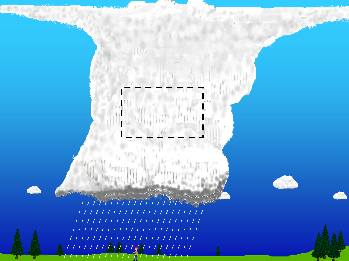 Thunderstorm Electrification
Thunderstorm Electrification
While the exact details of the charging process are still being studied, scientists generally agree on some of the basic concepts of thunderstorm electrification. The main charging area in a thunderstorm occurs in the central part of the storm where air is moving upward rapidly (updraft) and temperatures range from -15 to -25 Celsius.
At that place, the combination of temperature and rapid upward air movement produces a mixture of super-cooled cloud droplets (small water droplets below freezing),
small ice crystals, and soft hail (graupel). The updraft carries the super-cooled cloud droplets and very small

ice crystals upward. At the same time, the graupel, which is considerably larger and denser, tends to fall or be suspended in the rising air. The differences in the movement of the precipitation cause collisions to occur.
When the rising ice crystals collide with graupel, the ice crystals become positively charged and the graupel becomes negatively charged.
The updraft carries the positively charged ice crystals upward toward the top of the storm cloud. The larger and denser graupel is either suspended in the middle of
the thunderstorm cloud or falls toward the lower part of the storm. The result is that the upper part of the thunderstorm cloud becomes
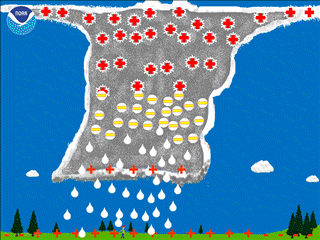
positively charged while the
middle to lower part of the thunderstorm cloud becomes negatively charged.
The upward motions within the storm and winds at higher levels in the atmosphere tend to cause the small ice crystals (and positive charge) in the upper part of the thunderstorm cloud to spread out horizontally some distance from thunderstorm cloud base. This part of the thunderstorm cloud is called the anvil. While this is the main charging process for the thunderstorm cloud, some of these charges can be redistributed by air movements within the storm (updrafts and downdrafts). In addition, there is a small but important positive charge buildup near the bottom of the thunderstorm cloud due to the precipitation and warmer temperatures.
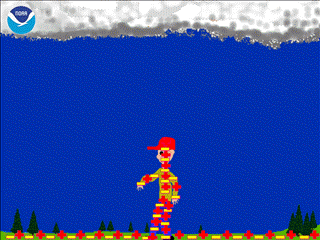
The charges on the ground are influenced by the charge build up in the clouds. Normally, the ground has a slight negative charge however, when a thunderstorm is directly overhead, the large negative charge in the middle of the storm cloud repels negative charges on the ground underneath the storm. This causes the ground and any objects (or people) on the ground directly underneath the storm to become positively charged.
As the negative charge in the cloud increases, the ground responds by becoming more positively charged. Similarly, the positive charge in the anvil can cause a negative charge to build up on the ground under the anvil
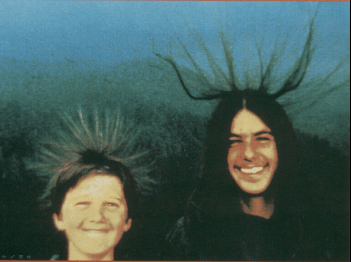
(which may extend far from the thunderstorm base).
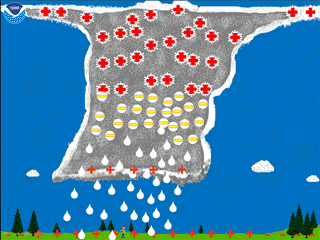 Types of Flashes
Types of Flashes
There are two main types of lighting: intra-cloud lightning and cloud-to-ground lightning.
Intra-cloud lightning is an electrical discharge between oppositely charged areas within the thunderstorm cloud.
Cloud-to-ground lightning is a discharge between opposite charges in the cloud and on the ground. Cloud-to-ground lightning can either occur between negative charges in the cloud and positive charges on the ground (a negative flash) or between positive charges in the cloud and negative charges on the ground (a positive flash).
Each cloud-to-ground lightning flash consists of one or more leaders followed by one or more return strokes. The leader is the initial step in the lightning flash and establishes the conductive channel that the electrical discharge (lightning) will take. There are different types of leaders. The most common type of leader is the negative stepped leader. Once a charged leader makes a connection with the ground, the return stroke occurs. The return stroke is simply the rapid discharge of electricity that has accumulated on the leader. We see this discharge as the bright flash of lightning.
Negative Flashes
Most lightning flashes are a result of negatively-charged leaders, called stepped leaders. These leaders develop downward in quick steps. Each step is typically about 50 meters (150 ft) in length. Stepped leaders tend to branch out as they seek a connection with the positive charge on the ground. When a branch of the stepped leader reaches within about 50 meters of the ground or some object on the ground, it connects with an upward-developing positive charge, often referred to as an upward streamer.
Upward streamers tend to develop from the taller objects beneath one or more branches of the stepped leader. When the downward-developing negative stepped leader makes contact with an upward-developing positive streamer, referred to as the attachment process, a conductive path is established for the rapid discharge of electricity that we see as a bright flash.
In general, stepped leaders travel at about 200,000 miles per hour, although speeds vary considerably. The highly visible return stroke moves upward through the leader channel at about 200 million miles per hour. The combination of the stepped leader and return stroke happens in just a fraction of a second. While both leaders and return strokes produce visible light (leaders produce a faint light that is more visible at night), they happen so quickly that the human eye cannot distinguish the two; however, high-speed cameras are able to capture the movement of leaders as they move toward ground.
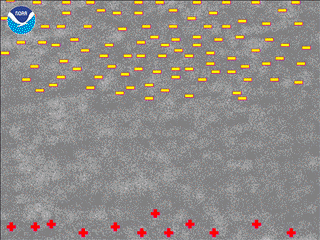 Initiation of a Stepped Leader
Initiation of a Stepped Leader
Stepped leaders develop within thunderstorm clouds when charge differences between the main region of negative charge in the middle of the thunderstorm and the small region of positive charge near the base of the storm become large. When those charge differences become too large, the insulating capacity of the air breaks down and the negative charge starts moving downward.
Typically, the small amount of positive charge at the base of the cloud near the developing channel is not sufficient to satisfy the negative charge that
as accumulated along the conductive channel aloft. Consequently, the negatively charged channel emerges from the bottom of the cloud
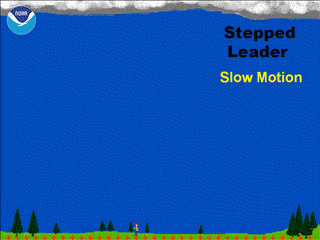
and continues to move toward the ground.
It is worth noting that the tip of the stepped leader does not sense the actual charges on the ground as it emerges from the cloud. Rather, as it moves out of the cloud, the stepped leader only senses charges within about 50 meters of the leader tip. As a result, the stepped leader surges ahead in 50 meter segments based solely on the charges in the air immediate surrounding the tip. Each surge of the leader produces a small flash of light which can be detected by high speed cameras.
As a result, the path of the leader from cloud to ground can

be very jagged and indirect. Consequently, the leader does
not take the path of least resistance from cloud to ground as it moves blindly toward the ground. In addition, the stepped leader generally branches outward
as it seeks a connection to the ground.
Depending on the electric field surrounding the step leader, individual branches of the leader may become more or less prominent.
While the stepped leader develops downward at a speed of 200,000 miles per hour, the leader would move much faster if it didn't pause between each of its steps downward.
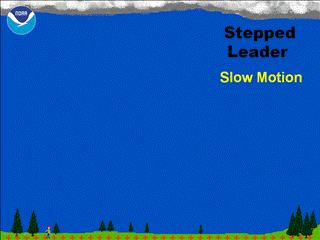
 Making a Connection With the Ground
Making a Connection With the Ground
During the development of the stepped leader, the positive charge on the ground increases. As the branches of the stepped leader approach the ground, the electrical forces between the leader tips and the tops of tall objects on the ground also continues to increase.
Eventually, these forces cause the air above the taller objects to become more conductive, to ionize. As it does, negative charge starts moving from the air to the taller objects and into the ground. The result of the negative charge moving toward the ground, is that the channel of air directly above the taller objects becomes positively charged. This is usually referred to as an upward streamer. Eventually, the negatively-charged, downward-moving stepped leader makes contact with one of the upward developing positive streamers.
When this contact is made, the lightning channel is complete and charges can flow rapidly from the cloud toward the ground. It takes only a fraction of a second to go from the stepped leader initiation to the final connection.
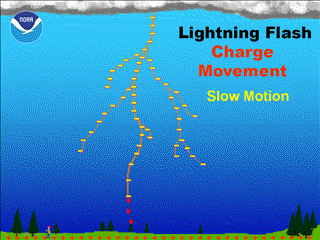 The Return Stroke
The Return Stroke
The return stroke is the very bright visible flash that we see as lightning, caused by the rapid discharge of electricity. Once the step leader makes contact with a streamer, the negative charge that has accumulated along the leader channel flows rapidly to ground. The movement of the charge starts at the point of contact and rapidly works its way upward as charge is drained from the channel.
Although the visible flash is associated with the rapid movement of charge downward, the actual flash propagates upward throughout the channel as the negative charge starts moving toward the ground .
This is similar to cars that have been stopped by an open
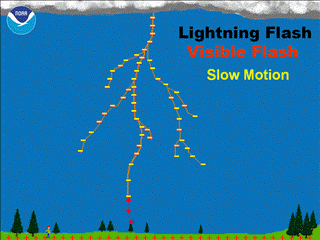
drawbridge. Once the drawbridge is opened for traffic, cars initially start moving forward toward the
bridge but movement across the bridge works its way backward through the line of stopped cars. For a moment after the initial return stroke, the channel remains
conductive and can be a favored path for subsequent downward leaders.
Subsequent Dart Leaders and Return Strokes
If additional negative charge is immediately available in the cloud in the vicinity of the initial return stroke, the additional charge may start to move toward ground in the conductive path left by the initial return stroke. These subsequent leaders are called dart leaders. Because the channel is already established, the charge can move down the main channel in a much smoother manner than the stepped leader, and at a much greater speed. Like the stepped leader, another return stroke will occur when they reach the ground. Because dart leaders just follows the main discharge channel, subsequent return strokes are not usually branched.
Typically, a negative flash of lightning will be comprised of an initial stepped leader/return stroke followed by 2 or 3 subsequent dart leaders/return strokes. Multiple return strokes will cause the lightning to flicker. While not all negative flashes have more than one return stroke, some negative flashes have been observed with more than a dozen return strokes.
A typical lightning flash is comprised of a stepped leader, positive streamers, the return stroke, and several dart leaders, each followed by return strokes.
All of this happens in a fraction of a second and cannot be discerned by the human eye which is overwhelmed by the bright return stroke.
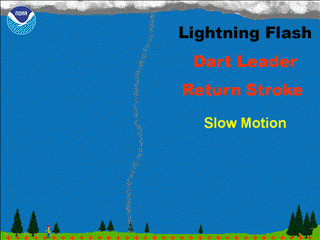
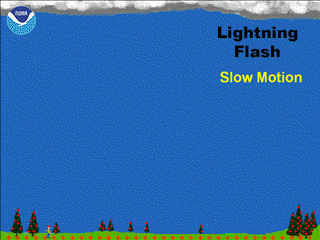
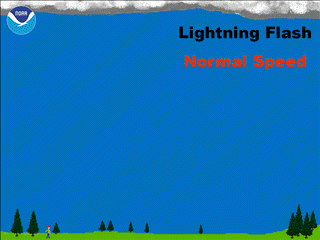
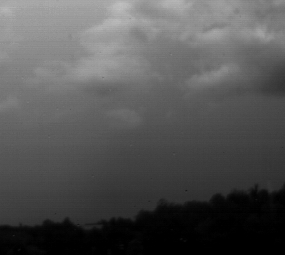 Slow Motion Video of Lightning Flashes
Slow Motion Video of Lightning Flashes
Recent advances in video equipment allow videographers to capture high speed images of lightning. These cameras are capable of capturing many stages of the lightning flash that the human eye cannot discern. When played back in slow motion, stepped leaders, upward leaders, streamers, dart leaders, and return strokes can be seen. The first video was recorded at 4000 frames/second. Played back at 30 frames/second, 1 second of recorded video lasts 2 minutes and 13 seconds.
Although somewhat overexposed, this video shows a highly branched step leader approaching the ground. When one branch of the stepped leader makes a connection, a very bright return stroke surges upward through the channel. Note that the actual time between the appearance of the stepped leader in the cloud until the return stroke is about 1/133 of a second. Only one return stroke was recorded with this flash.
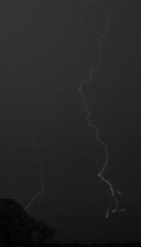

The next two videos show another example of a stepped leader. Unlike the previous example, this video shows just two main channels approaching ground. This video is less exposed than the previous example (which makes everything appear dimmer). In this case, the tips of the stepped leaders are racing toward the ground. The first to make a connection discharges the entire channel. Note that the actual time between the appearance of the stepped leader to the return stroke is about 1/50 of a second.
The second video in this set is the same as the first, except played back at an even slower rate to show the apparent movement of the return stroke as the two channels are discharged.
Video contributed by Dr. Marcelo Saba, National Institute for Space Research, Brazil
Ground Currents
When lightning strikes the ground or an object on the ground, the discharge occurs in and along the ground surface (not deep into the ground). This creates a dangerous and potentially deadly ground current near the lightning strike.
Ground current is responsible for killing many farm animals on a yearly basis. The threat of a fatal incident is affected by the distance between contact points with the ground and also the orientation of those contact points with respect to the lightning strike and discharge path. Farm animals have a long span between their front and back legs making them more vulnerable to ground current from a nearby lightning strike.
In humans, the risk of a lightning death or injury increases for a person lying on the ground because the greatest distance between contact points (usually between the head and feet) is greater than the distance of the contact points (2 feet) if the person was standing up. In the U.S., many lightning deaths and injuries are related to ground current.
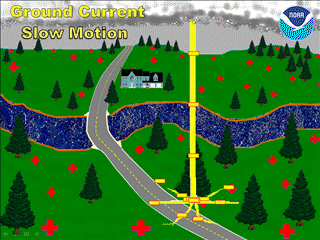


Positive Flashes
p>The previous section discussed flashes produced from downward-propagating negatively-charged leaders, commonly referred to as stepped leaders; however, about 10% of lightning flashes are positive flashes and are produced by downward-propagating, positively-charged leaders. While both positive and negative flashes are deadly, there are significant differences between the two in terms of their formation and behavior.
Positive leaders typically originate from the positive charged area in the upper part of the thunderstorm cloud. Normally, the ground is shielded from this upper positive charge by negative charges in the central part of the storm; however, when upper level winds are stronger than lower level winds and the storm becomes tilted, or when the anvil of the thunderstorm cloud spreads out ahead of or behind the updraft of the thunderstorm, the ground is no longer shielded from this upper charge. If charge differences between this upper level charge and the ground become too large, a downward-moving positively-charged leader can develop.
Because positive flashes often originate away from the main thunderstorm updraft, they often occur in areas some distance from where rain is occurring. Also, because the positive charge center is higher in the atmosphere and a much greater charge differential is needed to initiate a lightning flash, positive flashes occur much less frequently and are much larger distances between flashes. Consequently, many people are caught by surprise by positive flashes. Also positive flashes can precede the main part of the thunderstorm and the rain area by 5 to 10 miles or more.
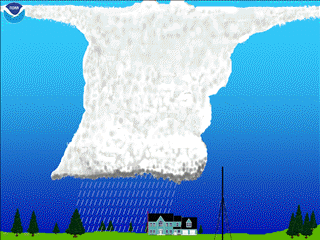 Upward Leader Discharges
Upward Leader Discharges
While most lightning is initiated by downward leaders, either negative or less frequently positive, upward propagating discharges, both negative and positive, are possible, but rare.
Upward discharges almost always occur from towers, tall buildings, or mountain tops. In addition, they are thought to occur only when there is a rapid change in the charges aloft, most likely due to a very recent lightning strike. Upward-developing discharges are usually branched upward.
Continuing Current and Hot Lightning
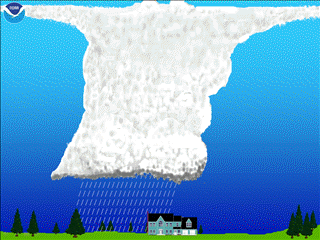
While most flashes consist of leader(s)/return stroke(s) combinations, some flashes contain what is called continuing current. Rather than charge flowing in one or more separate return strokes, charge flows continuously over a longer period of time through the lightning channel. Visually, flashes containing continuing current give the appearance of a continuously illuminated channel, as opposed to flickering, with varying degrees of brightness corresponding to the amount of charge movement. Flashes which contain both return strokes and continuing current are also common. These flashes will flicker, leaders/return strokes, and also have short periods of constant illumination, continuing current.
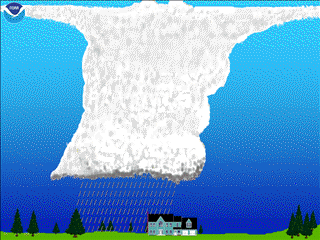
Lightning flashes containing continuing current are particularly important because they are more likely to start fires. In a typical return stroke, electricity flows for only a short period and does not generate the heat required to ignite a fire; however, in continuing current, electricity flows over a much longer period of time and will generate considerably more heat. Consequently, flashes with continuing current are much more of a fire concern. Because of the heat they generate, flashes with continuing current are sometimes referred to as hot lightning while flashes containing only return strokes are referred to as "cold lightning."
Thunder
Thunder is the sound caused by a nearby flash of lightning and can be heard for a distance of only about 10 miles from the lightning strike. The sound of thunder should serve as a warning to anyone outside that they are within striking distance of the storm and need to get to a safe place immediately!
Thunder is created when lightning passes through the air. The lightning discharge heats the air rapidly and causes it to expand. The temperature of the air in the lightning channel may reach as high as 50,000 degrees Fahrenheit, 5 times hotter than the surface of the sun. Immediately after the flash, the air cools and contracts quickly. This rapid expansion and contraction creates the sound wave that we hear as thunder.
Although a lightning discharge usually strikes just one spot on the ground, it travels many miles through the air. When you listen to thunder, you'll first hear the thunder created by that portion of the lightning channel that is nearest you. As you continue to listen, you'll hear the sound created from the portions of the channel farther and farther away. Typically, a sharp crack or click will indicate that the lightning channel passed nearby. If the thunder sounds more like a rumble, the lightning was at least several miles away. The loud boom that you sometimes hear is created by the main lightning channel as it reaches the ground.
Since you see lightning immediately and it takes the sound of thunder about 5 seconds to travel a mile, you can calculate the distance between you and the lightning. If you count the number of seconds between the flash of lightning and the sound of thunder, and then divide by 5, you'll get the distance in miles to the lightning: 5 seconds = 1 mile, 15 seconds = 3 miles, 0 seconds = very close.
Keep in mind that you should be in a safe place while counting. Remember, if you can hear thunder, chances are that you're within striking distance of the storm. You don't want to get struck by the next flash of lightning.
by positive flashes. Also positive flashes can precede the main part of the thunderstorm and the rain area by 5 to 10 miles or more.Acknowledgments and References
The NLSC thanks the following lightning researchers for their comments and suggestions.
The following books were used as references and are recommended for further reading.



